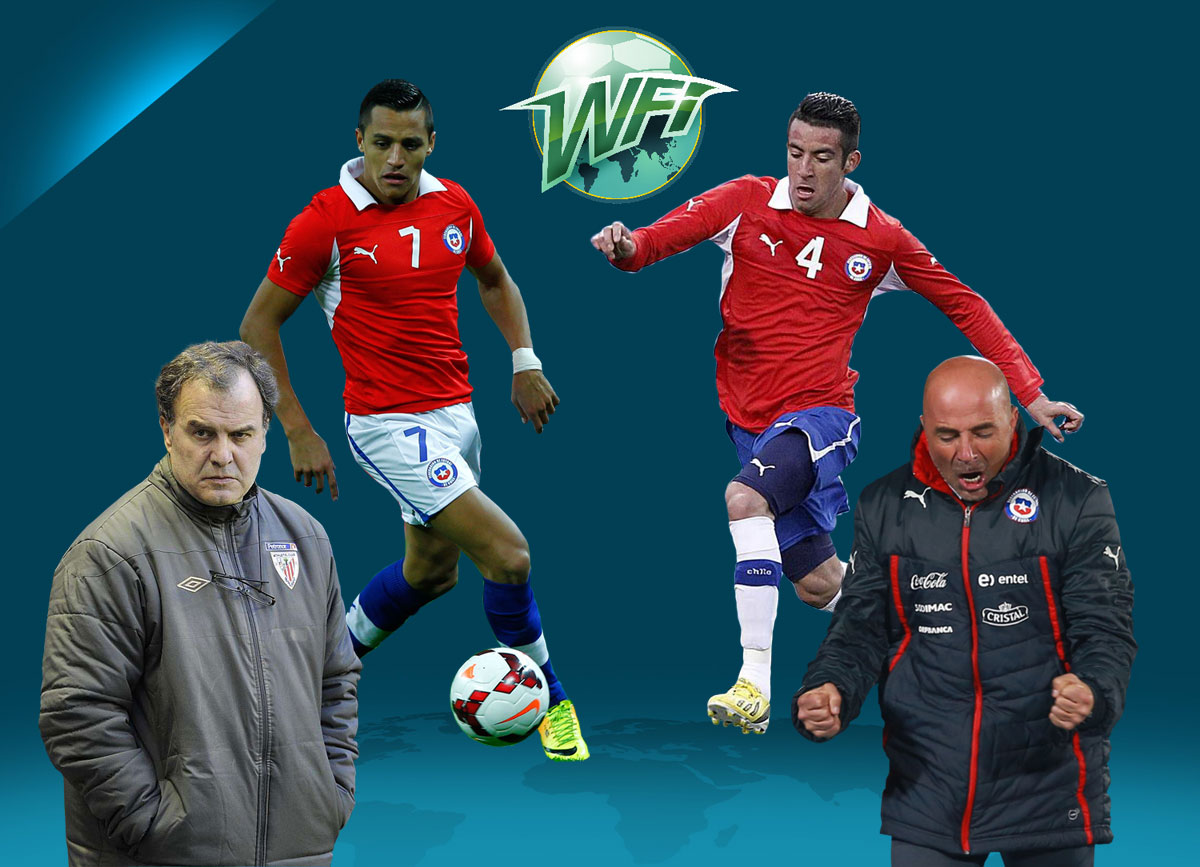Chile’s triumph at the 2015 Copa America on home soil was the result of years of hard work, player development, tactical maneuvering, and the evolution of an identity which began in 2007.
They have always boasted impressive individual talent. From the late 1960s and through the 70s they had, in the shape of Elias Figueroa, one of the best defenders to ever play the game. Then in qualification for the 1998 World Cup they operated with one of the greatest strike partnerships of all time.
It was rare to encounter a Chile game where one of Marcelo Salas or Ivan Zamorano weren’t on the scoresheet, and despite being knocked out by Brazil in the last sixteen of the tournament proper in France, Salas still managed to bag four goals..
This goal in a friendly against England at Wembley is well remembered, as Salas expertly controls a long ball from playmaker Jose Luis Sierra, before showing great technique to fire the ball past Nigel Martyn.
But despite the occasional outstanding individual, Chile needed something extra in order to overcome South American heavyweights Argentina and Brazil, and in 2007 the stars aligned.
It was during this year that they hired the progressive former Argentina manager Marcelo Bielsa, who brought a style which suited La Roja down to the ground.
At the same time, a Chile youth side had just finished third in the 2007 FIFA U-20 World Cup; a tournament which would go down in history as it gave football fans a glimpse of several players who are now household names. Sergio Aguero, Angel Di Maria, Luis Suárez, Juan Mata, Gerard Pique, Shinji Kagawa, Willian, and David Luiz were all included in their respective countries’ squads.
For Chile, Mauricio Isla, Gary Medel, Alexis Sánchez, and Arturo Vidal went to that 2007 tournament in Canada. All four were part of the starting eleven in the 2015 Copa America final.
Bielsa, an Argentine, had the tools required to play his brand of ceaseless pressing football, and in return Chile were given an identity they could call their own, rather than one copied from one of their bigger and more successful neighbours.
Chile showcased this new brand of attacking football at the 2010 World Cup, but were knocked out by Brazil in the last sixteen as they had been in their last World Cup finals appearance, 12 years earlier.
Despite the repeat result, progress had been made, so much so that Chile fans organised a campaign for Bielsa to remain as coach of their national side amidst rumours he would leave. Unfortunately for them, Bielsa resigned in February 2011, but his influence on Chilean football lives on.
Bielsa’s exit meant that 2011 would become an important year in Chilean football’s evolution. It coincided with the exploits of another Argentine manager, Jorge Sampaoli, who was leading one of Chile’s top club sides to continental success. The events of this year would shape the Chilean football landscape for years to come, and would go on to impact the game on a global scale.
Sampaoli’s Universidad de Chile side won the Primera División Apertura stage in June 2011, then in December they won the Clausura to confirm their place as the best club side in Chile.
The Santiago based club also won the 2011 Copa Sudamericana, attracting global attention to South America’s equivalent of the Europa league with their entertaining brand of football. Sampaoli had seen what Bielsa was doing with the national team, and decided to adopt this style at club level.
In 2012 he won the Apertura again, and did all this using a number of formations; the most notable being the Bielsa 3-3-3-1 / 3-3-1-3.
Marcelo Díaz, Charles Aránguiz, Eduardo Vargas, Mauricio Isla, Eugenio Mena, goalkeeper Johnny Herrera, and captain José Rojas were all part of that side. Four years later they were included in Chile’s 2015 Copa America squad under Sampaoli, with Vargas, Aránguiz, Diaz, and Isla playing in the final.
Being successful in our game – one where 22 players kick a round ball in unpredictable environments – always requires a certain amount of luck, but Chile had given themselves the best possible chance of succeeding in this all-important tournament on home soil.
The evolution of a tactical system led by two men from the same school, one the headmaster, and the other an outstanding former pupil, meant that this team of players could grow and then triumph thanks to a plan which was etched in their minds.
It’s a blueprint which has spread beyond its South American roots, going on to influence coaches around the world. It added an intensity and work ethic to the greatest team we’ve seen this century, as Pep Guardiola’s Barcelona adapted Bielsa’s style to their Spanish brand of total football, previously installed by Johann Cruyff.
This process allowed us to see the best of one of the game’s greatest ever players, as Lionel Messi danced to Bielsa’s tune. Both the idea and the player were born in Argentina, but they flourished in Spain through Guardiola, Tito Vilanova, and now Luis Enrique.
Chile, with their entertaining style and appealing but workmanlike football, have become the envy of many national teams, including those they once tried to copy. It remains to be seen whether their 2015 Copa America triumph is the tip of the iceberg, or if bigger triumphs lie ahead.
Maintaining this level and then developing this side further will be a difficult task, especially if the impressive Sampaoli leaves to manage elsewhere.


COMMENTS
Gwiz at last his influence on Pep begins to make sense